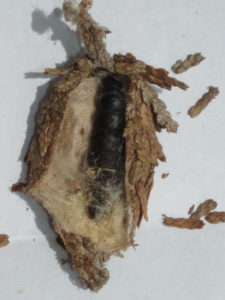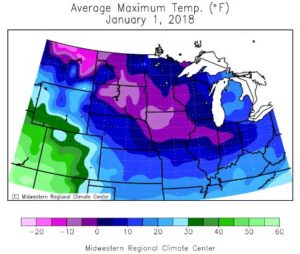Although winter weather came late this year, when it finally arrived at the end of December, it was fiercely cold with temperatures dipping well below 0 ˚ F. Most Indiana insects can survive these temperatures. One serious defoliator, the evergreen bagworm may have been killed by the cold weather.
What are bagworms?
Bagworms, Thyridopteryx ephemeraeformis (Haworth) are caterpillars that can strip the leaves from a wide variety of trees and shrubs. Evergreen shrubs, like juniper, red cedar, falsecypress, spruce, arborvitae, fir and pines can be killed when they lose more than half of their leaves to this pest. Although deciduous trees like maples, elms, birch, crabapples, willows and poplars are more likely to survive when they lose their leaves, affected trees are unsightly and repeated defoliation is likely to kill these trees.
Bagworms get their name from their habit of living inside a silk bag that they cover with bits of leaves and needles as they feed. In the summer they carry these leaf coated bags as they feed on the canopy.
Bagworms hatch from old bags, filled with eggs in late May or early June. Young caterpillars crawl out of the bags and either crawl to new leaves, or are blown on silken strands to new plants. Caterpillars continue feeding through August when winged male bagworms fly out of their own bags to mate with wingless females. Bags of mature females can be up to 2 inches long and are often mistaken for pinecones.
 The female lays her eggs inside her body cavity, where they remain until they hatch into caterpillars during the following spring (figure 2 female filled with eggs).
The female lays her eggs inside her body cavity, where they remain until they hatch into caterpillars during the following spring (figure 2 female filled with eggs).
Why is cold weather more likely to kill bagworms than other insects in Indiana?
Unlike many insects who insulate themselves from the cold by burying below the soil surface, bagworm eggs dangle in bags from branches, well above the soil. Also, they lack the protective mechanisms that many other insects have to protect their tender tissues from ice crystals that form during the freezing process. Research conducted at Purdue shows that most bagworm eggs can die when they are kept below -0.6˚ F for 24 hours. So, if the daily HIGH temperature is less this temperature you may not have a bagworm problems
What should You do?
Examine this weather map to see if you live in areas that were warmer than 0 ˚ F. If so, you will probably have most of your bagworms surviving and will have to plan to manage this insect with insecticides as you have in the past. If you do live in areas where it was colder than 0 ˚ F you should check your bagworm infested plants for new bags starting in late May (Figure 4). Plants are best protected by applying insecticides to the leaves when bags are small, and caterpillars have removed leaves. Homeowners can use spinosad (Fertilome Borer and Bagworm Killer, or Captain Jack’s Deadbug) to kill bagworm. Other products, such as carbaryl (Sevin) can also be effective, but may cause spider mite problems. 